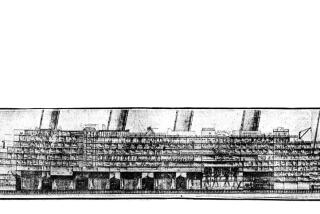Women and children first? Maybe
Whether it is âWomen and children firstâ or âEvery man for himselfâ in a shipwreck may depend on how long it takes the ship to sink, researchers said Monday.
When the Lusitania was torpedoed by a German U-boat in 1915, it sank in 18 minutes and the bulk of survivors were young men and women who responded immediately to their powerful survival instincts.
But when the Titanic struck an iceberg in 1912, it took three hours to go down, allowing time for more civilized instincts to take control. -- and the bulk of the survivors were women, children and people with young children.
Economist Benno Torgler of the Queensland University of Technology in Australia and his colleagues studied the two sinkings in order to explore the economic theory that people generally behave in a rational and selfish manner. The two tragedies provided a ânatural experimentâ for testing the idea, because the passengers on the two ships were quite similar in terms of gender and wealth.
The primary difference was how long it took the ships to sink.
Reporting in the Proceedings of the National Academy of Science, the researchers found that, on the Titanic, children had a 14.8% higher probability of surviving than a man, a person accompanying a child had a 19.6% higher probability and women had more than a 50% higher probability.
On the Lusitania, in contrast, fit young men and women were the most likely to make it into the lifeboats.
Social class was also important. On the Titanic, first-class passengers were about 44% more likely to survive, while on the Lusitania, passengers from steerage were more likely to emerge safely.
The authors considered other possible complicating factors, but concluded that the most likely reason for the differences was the amount of time passengers had to effect escape.
They suggested that when people have little time to react, gut instincts may rule. When more time is available, social influences play a bigger role.
Ed Kamuda, president of the Titanic Historical Society in Indian Orchard, Mass., agreed with their conclusion that the very different circumstances of the wrecks could have affected peopleâs behavior. âThe Lusitania sank so quickly, and half of the lifeboats couldnât even be used,â he said. âThe younger crowd would be able to make it into the boats, could jump into them as they swung away from the ship. The Titanic was pretty well on an even keel, and they had all sorts of time.â
But psychologists noted that many factors other than following social norms could come into play in a disaster, including an evolutionary imperative to save the species, attachments that are formed between individuals during the event and the leadership of authority figures.
The extent of altruism and how it occurs âis a very controversial issue,â said Anthony R. Mawson, a professor of preventive medicine at the University of Mississippi Medical Center. âI surmise that the dominant response was affiliation/attachment behavior.â
In a rapid event, such as the Lusitania sinking, attachments would have been to people the passengers already knew. But when a disaster is spread out over hours, as was the case with the Titanic, âpeople who had previously been complete strangers become the equivalent of loved ones,â Mawson said.
Psychologist Daniel Kruger of the University of Michigan thinks that the answer lies less in social norms and more in our evolutionary heritage. Human beings have a deep instinct to preserve our kind, he said, and that means âpeople are more likely to save those who have higher reproductive value, namely the young and women in child-bearing years.â
Kruger also stressed the importance of leadership during an emergency, noting that the Titanicâs captain appeared to exert greater control than the Lusitaniaâs. He compared the sinkings to the recent ditching of US Airways Flight 1549 into the Hudson River. In that case, Capt. Chesley B. âSullyâ Sullenberger was firmly in control and his edict that women and children should exit first was followed, even though the plane was in imminent danger of sinking.
âPeople might be in a state of panic, but if they are reassured there is a system in place, they might be more likely to go along with contingency plans,â Kruger said.
The researchersâ theory may fit well for the Titanic and Lusitania, but may not be generalizable.
Kamuda pointed to two other disasters, the 1873 sinking of the Atlantic on rocks off the coast of Halifax, and the 1914 sinking of the Empress of Ireland in the St. Lawrence River after it was hit by another ship. Both events took about an hour. But not a single woman and only one child survived the Atlantic disaster, while the majority of survivors from the Empress were women.






